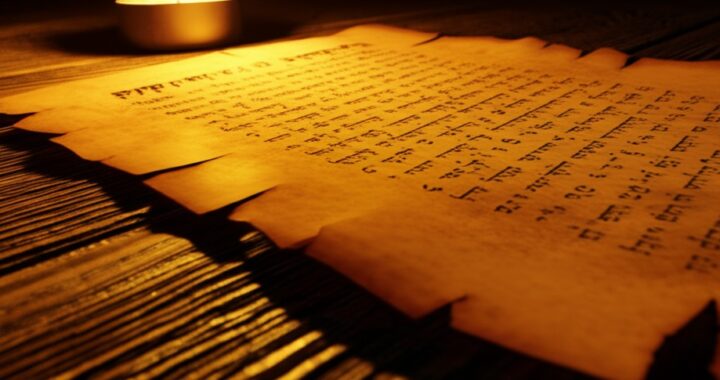The Bible has much to say about Israel—past, present, and future. This small plot of land, this scattered people throughout the world, are precious in the sight of the Lord (Zech 2:8). The prophets prophesied a bright future filled with abundance and blessing. On the eve of blessing, however, will be a time of great trial. The persecutor of Israel will prevail, conquering rulers, brutally ruling over his own people, and leading a worldwide persecution of the Jewish people.
Israel’s deliverer will not come from a political alliance, but from the true King of Kings who will usher in a time of eternal blessing. Isaiah’s oracle against Babylon describes the cosmic victory of the King of Kings (Isa 13:2–13), over the fake king of kings over whom regathered Israel will raise a taunt (14:3–21). The identity of this king of Babylon becomes apparent through a detailed analysis of Isa 13:1—14:27. This king of Babylon is the eschatological archnemesis of Israel. 1
Eschatological or Historical Battles
Isaiah 13:2–13 describes an eschatological battle between God’s holy, angelic warriors (13:3, 5) who originate from the end of heaven to do battle with the assembled kingdoms of nations upon the mountains [presumably the mountains of Jerusalem (13:4)]. The day of the Lord has arrived, and the reader is commanded to “Wail!” (Isa 13:6). The Lord’s warriors mete out the righteous wrath of the Lord upon the wicked (13:9, 11) which includes apocalyptic disturbances in heaven and on earth (10, 13).
Isaiah 13:2–13 sounds eschatological, but many believe Isa 13:14–22 is historical. The battle between the Medes (13:17) and Babylon (19) recalls Cyrus’ Medo-Persian coalition which toppled the Babylonian empire in 539 BC and led to the regathering of Israel (14:1–2). Oswalt, for example, claims Isa 13:2–13 is eschatological, but 13:14–22 is historical because “there is a turn toward more this-worldly imagery with a special emphasis upon the savagery with which the proud city will be thrust down.” 2 Indeed, the savage Median destruction includes extensive death without quarter (15), dashing of children (16), rape of women (16), and eternal devastation of Babylon (19–22). Cyrus’ Medo-Persian army, however, conquered Babylon peaceably. Babylon continued to exist in succeeding centuries and continues to be inhabited today. 3 Wildberger acknowledges the historical disconnect and argues that the prophecy failed, “The author of Isaiah 13 anticipates that there will be a complete destruction of the city. In this, he was to be disappointed.” 4 Wildberger’s presuppositions (denial of Isaianic authorship and naturalistic interpretation of Scripture) do not allow him to consider a future fulfillment.
Instead of claiming, “Isaiah made a mistake,” scholars should consider that Isa 13:14–22 still awaits fulfillment. As the kingdoms of nations are destroyed on the mountains of Jerusalem by the Lord’s angelic army (13:2–13), the Medes descend upon Babylon and wreak eternal destruction upon the capital city of the king of Babylon (13:14–22). Exegetical support for this position comes from the phrase “and it will be” (והיה) which divides the oracle at Isa 13:14 and 14:3. Furthermore, Isaiah 13:2 and 14 both begin with delayed anticipation, describing different battle scenes. When eschatological Babylon is destroyed (13:14–22), then eschatological Israel will be regathered (14:1–2).
The Eschatological Regathering of Israel
Isaiah 14:1–2, similarly, describes an unfulfilled regathering of Israel into the land. Israel will have rest in their own land, be escorted back to their homeland by foreigners, take captive their captors, and rule over their former oppressors. The regathering of Israel described in Isa 14:1–2 was not fulfilled after the conquest of Cyrus. Heater agrees, “The language of the passage forces the interpreter who is trying to take the language seriously to see a future for Israel that far exceeds what happened when Cyrus permitted the Jews to return to Jerusalem (as in 11:11ff).” 5 The history simply does not match. The regathering of Israel in Isa 14:1–2 will be fulfilled following the eternal devastation on Babylon (13:14–22) and eschatological destruction of the kingdoms of nations (13:2–13).
The Eschatological Ruler of Babylon
Isaiah 14:3–4 confirms that the king of Babylon concerns eschatological Babylon, “And it will be in the day the Lord gives you rest from your sorrow . . . that you will take up this proverb against the king of Babylon.” The rest recalls Isa 14:1, “The Lord will make them rest on their ground.” All of these events concern the same eschatological time period. The children of Israel will taunt the king of Babylon when the Lord establishes them in their land (14:1–2) which happens when Babylon is eternally destroyed (13:14–22). An analysis of Isa 14:4–21 reveals the attributes and activities of Israel’s eschatological enemy.
Attributes of the King of Babylon
Isaiah 14:4–21 reveals five attributes of the king of Babylon. The first is that he is the king of Babylon. Many believe Babylon could be symbolic for a world power that opposes God; however, the Old Testament never refers to Babylon symbolically. 6 Furthermore, the reference to the Chaldeans (Isa 13:19) argues for literal Babylon. The king of Babylon is also a brutal ruler striking “peoples” and “nations” with “unceasing blows” (14:6). This characterizes not the conquest of his enemies, but the manner of his rule. Nebuchadnezzar, Alexander the Great, and other great rulers from times past may have treated their enemies harshly, but not their own people. Third, the king of Babylon rules over a vast domain [peoples and nations (14:6)] and makes earth and kingdoms tremble. His influence reaches beyond the borders of his own vast empire and invokes fear in the hearts of the other rulers upon the earth.
Fourth, he is the king of mortal kings which is proven from two metaphors. First, the dead kings of ages past rise from their thrones at the approach of the king of Babylon. Fabry explains, “The throne is the ruler’s center of power; here he pronounces his threats against rivals. To . . . ‘sit upon’ it is synonymous with ‘being king.’” 7 Isaiah personifies Sheol who forces the dead kings to stand in respect before the king of Babylon. Second, the king of Babylon is the brightest star and conquers nations (Isa 14:12–14). While this text is often confused with the power behind this ruler (Satan), the context clearly has the physical king of Babylon in mind. The punishment concerns this arrogant ruler (Isa 14:15–16), not the spiritual force which empowers him (Satan). The king of Babylon defeats (חלש֝) nations (not Satan) and shines the brightest (14:12). He is the brightest star (ruler) over the other “stars of God” (other rulers; Isa 14:13). Similarly, in Rev 22:16 Jesus identifies himself as the “Bright and Morning Star.” The king of Babylon functions as the antithesis of the true Morning Star. He is the false king of kings, and will be supplanted by the true King of Kings—Jesus the Messiah.
Finally, the king of Babylon’s corpse will not be buried (Isa 14:18–20). Exegetically, it is difficult to determine if his corpse is exhumed or simply never buried. In either case, leaving a corpse exposed was a great dishonor in the ancient world and this dishonor befalls the king of Babylon.
Activities of the King of Babylon
Isaiah 14:4–21 reveals six activities of the king of Babylon. First, he harvests Lebanon’s trees (Isa 14:16). Ancient kings wrote of their desire for the trees of Lebanon, the biggest and the best trees. While the king of Babylon may acquire beautiful trees from Lebanon with which he may adorn his kingdom, more likely these trees metaphorically refer to kings and rulers whom he chops down (e.g., Isa 2:13; 10:15; Dan 4).
Isaiah 14:17 discloses three activities: he makes the world (תבל) a wilderness (Isa 14:17a), destroys cities (Isa 14:17b), and does not release prisoners (Isa 14:17c). The final point of this tricolon has garnered significant attention. The parallelism of the verse argues that “not releasing prisoners” is the greatest act of wickedness. Compared to worldwide devastation and destruction, however, not allowing prisoners to go home seems comparatively insignificant. The prisoners, however, are not the king of Babylon’s prisoners, but the world’s (world is the nearer referent for the pronoun). Furthermore, in Isa 14:1–2, Israel and Judah are identified as liberated captives. The king of Babylon appears to have touched the apple of God’s eye and led a worldwide captivity of God’s chosen people—a captivity ended by the Lord himself (Isa 13:2–13).
The last two activities of the king of Babylon concern his treatment of his own people— he destroys his own land and kills his own people (Isa 14:20bc). A king should have functioned as God’s vice regent and brought peace and prosperity to his people and his land. The king of Babylon, however, wrought destruction for all—friend and foe alike.
Conclusion
Attempts to find a historic “king of Babylon” which correspond to the details of Isa 13—14 have proven futile time and again (see chart below). The king of Babylon will one day destroy the world, terrorize its people, and lead a worldwide persecution of God’s chosen people—Israel. The Lord will return and crush the “kingdoms of nations” force which opposes him (Isa 13:2–13), emboldening the peoples around Babylon to descend upon the city and wreak an everlasting destruction upon the city (13:14–22). Israel will be regathered to her land and finally live at peace (Isa 14:1–2). At this time, Israel will raise this proverb against the king of Babylon (Isa 14:3–21) who oversaw their persecution and imprisonment. Those who took Israel captive will become Israel’s captors (Isa 14:2). The Lord himself will deliver His people in that day, and all peoples will know that the Lord is the Savior of Israel, their Redeemer, their Warrior (Isa 49:8–26).
Works Cited- For a full analysis, see Timothy Allen Little, Israel’s Eschatological Enemy: The Identity of the King of Babylon in Isaiah 14:4-21 (Eugene, OR: Wipf and Stock, 2020).[↩]
- John Oswalt, The Book of Isaiah: Chapters 1–39, New International Commentary on the Old Testament (Grand Rapids: Eerdmans, 1986), 307.[↩]
- For more information see Hassler who concludes, “At no time in ancient, Medieval, or modern history has [the perpetual forsaking of Babylon] occurred. This suggests that the fulfillment still looms,” Mark Hassler, “Isaiah 13:1–14:27: The Babylonian Tyrant and the Morning Star” (Th.D. diss., Sun Valley, CA, The Master’s Seminary, 2013), 48.[↩]
- Hans Wildberger, Isaiah 13–27, trans. Thomas H. Trapp, Continental Commentaries (Minneapolis: Fortress, 1991), 29.[↩]
- Homer Heater, “Do the Prophets Teach That Babylonia Will Be Rebuilt in the Eschaton?,” Journal of the Evangelical Theological Society 41, no. 1 (March 1998): 30.[↩]
- Ringgren, among others, does not acknowledge a symbolic use of Babel in the Old Testament (Ringgren, “בָּבֶל,” TDOT 1:466–69).[↩]
- Fabry, “כִּסֵּא,” TDOT, 7:237.[↩]

Dr. Timothy A. Little
Timothy A. Little (PhD, Baptist Bible Seminary) is Assistant Professor of Old Testament at Faith Baptist Theological Seminary in Ankeny, IA. He has authored one other book, Song of Songs for Singles, and several articles. He regularly speaks, leads Bible studies, and writes on the Song of Songs. He is also a cohost on The Thinklings Podcast.

Dr. Timothy A. Little
Timothy A. Little (PhD, Baptist Bible Seminary) is Assistant Professor of Old Testament at Faith Baptist Theological Seminary in Ankeny, IA. He has authored one other book, Song of Songs for Singles, and several articles. He regularly speaks, leads Bible studies, and writes on the Song of Songs. He is also a cohost on The Thinklings Podcast.



